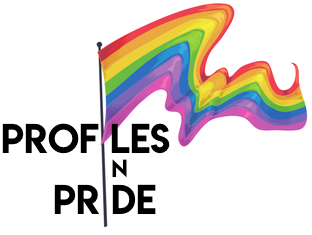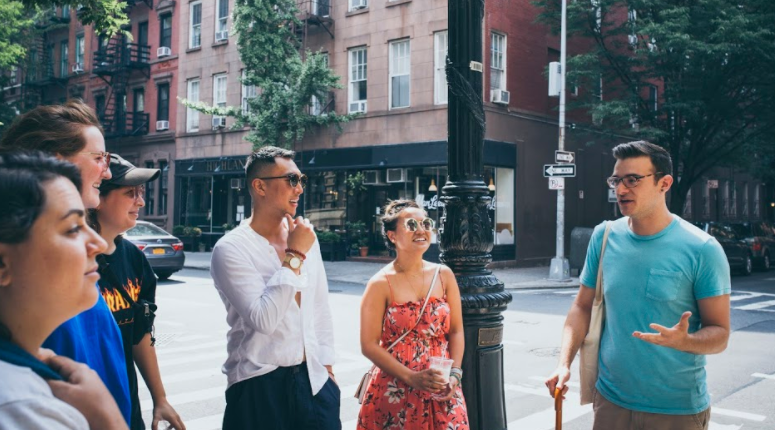Growing up in a very traditional, suburban part of Upstate New York in a Catholic family, Michael Venturiello wasn’t exposed to any other LGBTQ people. He also didn’t learn about any other queer people in school, so like many other young LGBTQ people, he thought there was something wrong with him and that he was completely alone.
He moved to Geneseo for college — an even smaller town in Upstate New York — but since it was a college town and not far from the bigger city of Rochester, it was more diverse than where he grew up. Venturiello quickly learned that he was far from alone, and he began the process of coming out as queer. He also began learning about LGBTQ history, but it felt far away, both time-wise and geographically.
Then about three years ago, he moved to New York City, where he says he really began to blossom. Living in the city where so much LGBTQ history took place, Venturiello began to immerse himself in learning more about the culture and legacy of the community. He wanted to go on a tour of LGBTQ history, but he found few options.
While he had a day job working for New York University, Venturiello decided to launch his own LGBTQ history tour company, Christopher Street Tours, in his spare time. After thoroughly immersing himself in LGBTQ history, he began offering walking tours around New York City that aren’t just about landmarks, but about the stories of people who changed the world.
Venturiello’s clients run the gamut, and he enjoys teaching anyone who’s interested about the fascinating queer history of New York. But but he especially loves whenever his tours are taken by LGBTQ youth, to whom he offers free admission. Being able to show them the representation and support he didn’t receive when he was younger is his passion. He also loves using the tours as a platform to help younger people realize that those who made history were just regular people like them, and anyone can be an agent of change.
Now 28, Venturiello continues to work for NYU by day and give tours in his free time, though he hopes one day to run Christopher Street Tours as his full-time job. This is Venturiello’s story of coming out as queer, finding a passion for LGBTQ history, and creating his own tour company to share this knowledge and empower everyone in the community — especially youth.
Profiles in Pride: What did coming out as queer look like for you?
Michael Venturiello: It’s interesting because my professional and personal journeys are so intertwined. I grew up in Upstate New York, in a very white, straight, suburban area. I grew up without any sort of role models in the queer community. I didn’t really know or understand what it meant to be queer or LGBTQ; there weren’t really any people representing those communities. We didn’t learn about it in K-12 school; we learned no LGBTQ history or about LGBTQ people.
So for a long time, I really thought I was the only LGBTQ person in the world or that something was wrong with me because I was different, and it was perceived in a more of a negative way. I also grew up Roman Catholic, and there can be some negative connotations within the church system and what that entails.
I think my understanding as a queer person growing up was that it wasn’t OK to be gay. It wasn’t until I left for college, which I feel like is a pretty typical experience, where I met people like me for the first time. It was this really mind-blowing revelation that I had been longing for. I realized that being attracted to other men — and other men being attracted to me — wasn’t just this gross phenomenon; it was something that was real and passionate and loving.
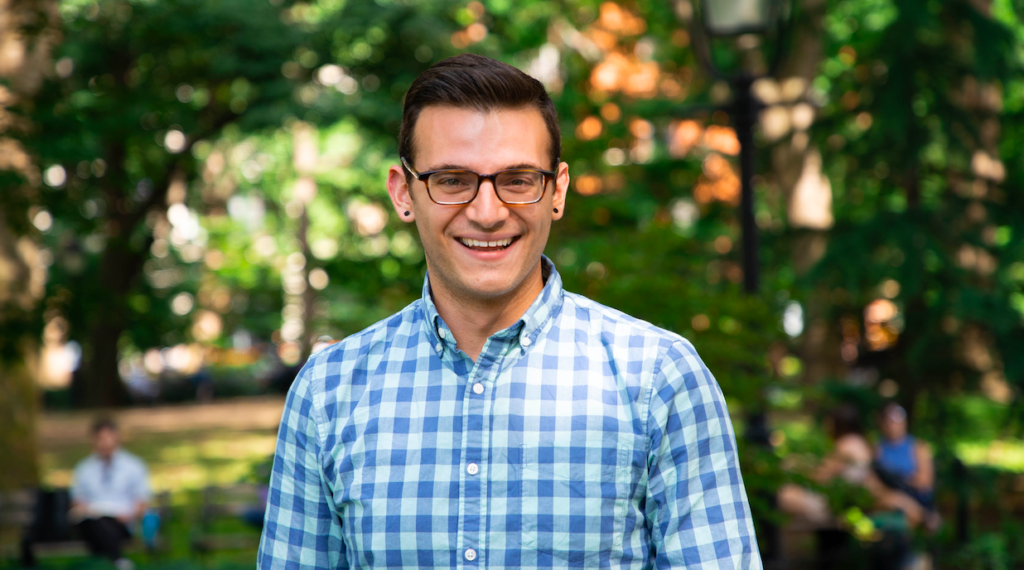
Moving to college was an eye-opening experience, and that’s when I came out. After that, I moved to a very small town in Upstate New York for a job, and I was transported back to my suburbian perception where people thought of me as the only gay person in the town.
Then I moved to Buffalo, New York, which in most people’s minds is definitely not a big city, but for me it was like, wow, this is a city with other queer people! That’s where I went to my first gay bar and had that kind of experience. Then I left and moved to New York City, and that was about three years ago. That’s where I really began to blossom. It’s been an amazing journey for my own professional identity, but also for my sexual identity. It has been really eye-opening in the last three years; I’ve learned so much about who I am.
PIP: How did moving to New York City impact you?
MV: I moved to New York City and I was working in student affairs at NYU in residence life. It was a great opportunity; I was working with 600 18-year-olds and I was living with them in the same dorm. It was great, but also really challenging for the way you can image as a 26-year-old living among 600 18-year-olds. There wasn’t a lot of personal space. Any free time I had was interrupted by something like a student smoking marijuana on the floor!
I remember on one of the more challenging days, I was having a night where I just wanted to curl up in my bed and watch Netflix. I pulled up David France’s documentary “How to Survive a Plague,” which is about the AIDS epidemic in New York City in the ‘80s. That was my first moment of, “Wow, there’s so much history that has happened here.” But it feels very real, because the documentary also explains that the AIDS epidemic is not over; this is still an issue we’re fighting for in New York City and around the world to get access to treatment.
There had been a time where I was researching Greenwich Village in the 1960s and 1970s for a historical fiction novel I was working on. But I was doing my research in Buffalo, in Upstate New York, and it felt very far away, both geographically speaking and also timeline since it was 50 years ago. I knew it mattered, but it didn’t feel like it was as modern as current history.
It wasn’t until I pulled up that documentary and realized that the research I was doing on Stonewall and Greenwich Village in the ‘60s through the AIDS epidemic in the ‘80s and through now — it’s so relevant to queer folks today. And I’d argue the mainstream community as well.
After I watched the documentary, the main organization it highlighted was ACT UP, the AIDS Coalition to Unleash Power. They were an organization that was formed in 1987 essentially with the goal of finding a cure for AIDS or ending AIDS. I did a quick Google search and found a website that literally looked like it was still 1987, but it said that it had been updated in 2016. They still meet every Monday night at the LGBT center, so I went to a meeting and started to get more involved in activism in that kind of way.
I realized I didn’t feel the most comfortable in the traditional activism space, like in the sense of protesting government buildings, or screaming chants and holding signs in Washington Square Park, or putting your fist up. I didn’t really feel comfortable in that; not for any other reason than I’m typically a very introverted person, so to be around those types of crowds and using my voice in that kind of way wasn’t necessarily a good fit.
But there was a man who co-founded ACT UP, Larry Kramer, who used his voice, and he was very vocal and aggressive to get what he needed to end this epidemic. But he also wrote; he wrote many books, plays, and articles. Larry Kramer taught me that through history, I could use my voice in a way that was a better fit for me, which is where the tours started to come into play.
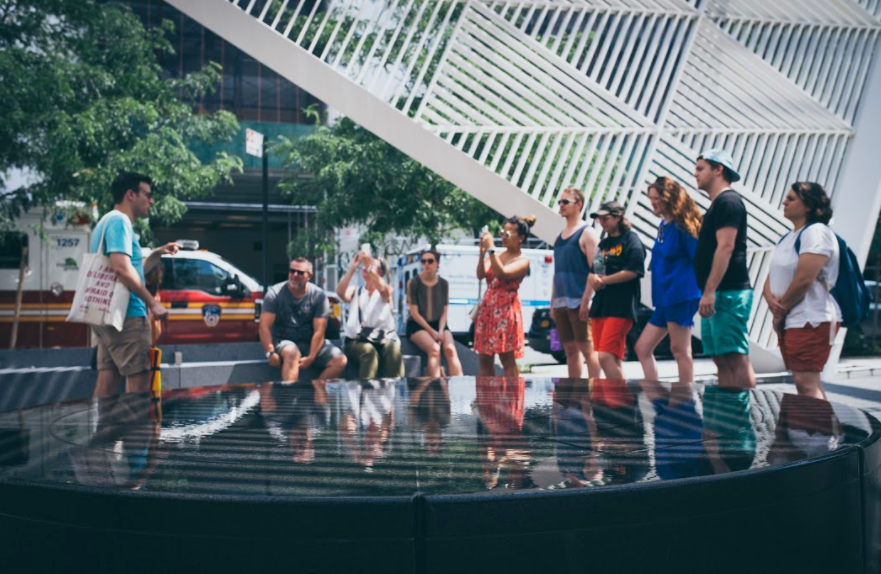
I started to reflect and realized ACT UP wasn’t the best fit for me, but I did have all of this research I’d done for this novel I was working on. I’m in New York City, and I wanted to take a tour to learn more about the history in general. But there wasn’t one — there weren’t any LGBTQ tours that I could find that weren’t only operating during the month of June.
A lot of the Pride tours only happen in June in New York City, or they’re a part of a much larger tour company that also does Times Square and the Statue of Liberty. Not that there’s anything wrong with that, but I think there’s a very different feel when the tour you’re going on is an LGBTQ-owned and operated tour with LGBTQ tour guides that only focuses on LGBTQ history.
I saw a really big gap in that market, and in my own understanding and knowledge and research. Rather than being sad about that and wishing there was something, I decided to just do it. I created a tour, with a route out of the history I’d already known, and filled in some of my own historical gaps, and then started marketing!
PIP: Are you doing Christopher Street Tours full-time now?
MV: No, I have a new job at NYU. I left the dorm and work full-time in our center for student life, and on the side I do Christopher Street Tours. I’d love to do it full-time one day. It’s exciting to hear about World Pride and the 50th anniversary of the Stonewall Riots; it’s all coming up this June, so it’s allowing me to really see what my life would be like working full-time for Christopher Street Tours and making it into something huge.
I think it could be, only because people really want this knowledge and information. I’m not the only one who didn’t learn about LGBTQ history. I’m not the only one who wants to feel more connected to their roots and the history and the people who paved the way before us. Having that sort of mindset with a huge population of people, not in just in New York City but across the country and across the world, I think would really fuel something into Christopher Street Tours that I’m hoping for one day.
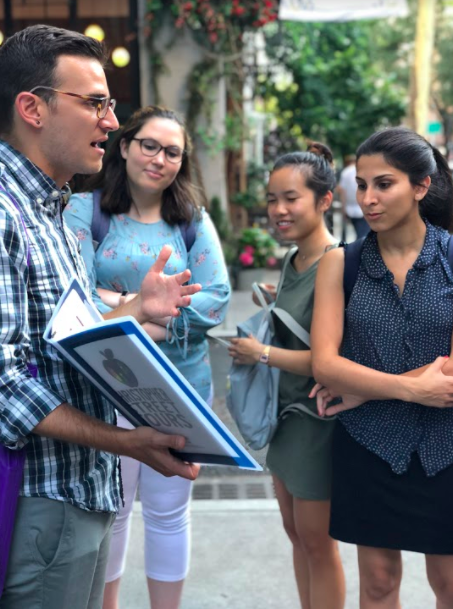
PIP: I know on Instagram you post about how you love showing this history to LGBTQ youth and that it’s about more than just landmarks. Why is that?
MV: When I first started giving the tours, the very first tour I gave was to friends, so it was just sort of a test run. At the end I realized it was really boring; all I was talking about were the historical pieces like the monuments and the landmarks. It felt like I was reading a textbook.
Since then, I have thought about, what is the point? Why am I giving these tours? Why are people coming on these tours, and what do they want to learn? What I gathered is they don’t necessarily care that the riots happened in 1969 at Stonewall. The year isn’t necessarily important. What’s more important is understanding the message and lesson that’s taken away from these huge moments, or even small moments, in LGBTQ history.
It’s really inspiring to me, and part of the reason why I founded the company in the way that I did was specifically with students in mind, because they don’t often get this history in school. Although I’m still a relatively young person, I’m in an older generation than the next generation, which I might consider to be anywhere from birth to 18 or 20. It’s a different mindset and a very different generation from me, even though I’m only eight years older.
In terms of what I hope people are getting on the tour, and this is everyone, but LGBTQ youth specifically, is there are so many examples of how all the things that I’m talking about were just regular common, modern people just like you and I. They saw something, either didn’t like it or wanted to make a change, and acted on that and rose up.
There are so many examples; it doesn’t have to be a huge Stonewall uprising. We talk about someone who opened up the first LGBTQ bookshop in the world, the Oscar Wilde Memorial Bookshop, because he was interested in that and felt a need in the community, and turned out to be a huge, inspiring landmark and it still is.
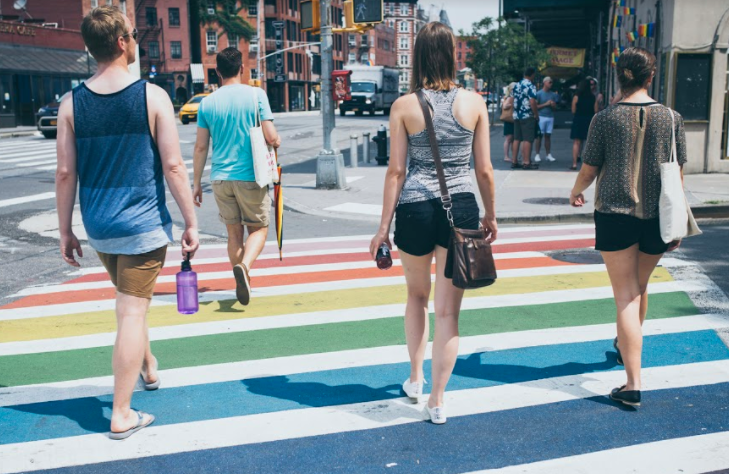
What I hope LGBTQ youth and people in general can get out of this is that you can also make change — you are the next generation of change makers. It’s so easy to look back and say, “These are the people who sparked the movement and started everything,” and that’s true, but I think people don’t necessarily connect the dots to the modern movement and current movement to think and say, “This is still going on, there are still people within our community we need to advocate for.” Whether that’s protesting or otherwise, there are a lot of ways people can get their voices involved.
What I love about it the most is that the majority of the LGBTQ youth I work with or have come on the tours are from these really rural, white, straight places, like where I grew up. We just had a student the other day who came from Arizona who felt like they were the only person in their school district, school and church who was LGBTQ.
I think part of the tour is to say, “You’re not alone. You have this whole history behind you. Even when you go home to your white straight town, know you have 50+ years worth of other LGBTQ folks who felt the exact same way as you and they were able to make change and make a big difference.”
Even if it’s just in your small community, if it’s one person, if it’s one friend, that can really make all the difference.
PIP: Do you get a lot of parents bringing their LGBTQ kids on the tour?
MV: Yes, that’s another one of my favorite things about the tour. Especially recently, there have been a lot more families reaching out and coming on the tour. I really love working with the families in that kind of way because they always have so many questions, like, “Will there be any bars on the tour or inappropriate information?”
I’m always so cautious. I say, “We do talk about sexual liberation in the’ 70s and what that means and how important that was, but how that unfortunately led to the rapid spread of HIV and AIDS and what we now know as the AIDS epidemic, and how it was sexually transmitted.” I’m erring on the cautious end but the parents are like, “Oh no, it’s fine. They know all about that.” I’m like, “Oh my gosh this is a different world!” It’s a different time and a different generation.
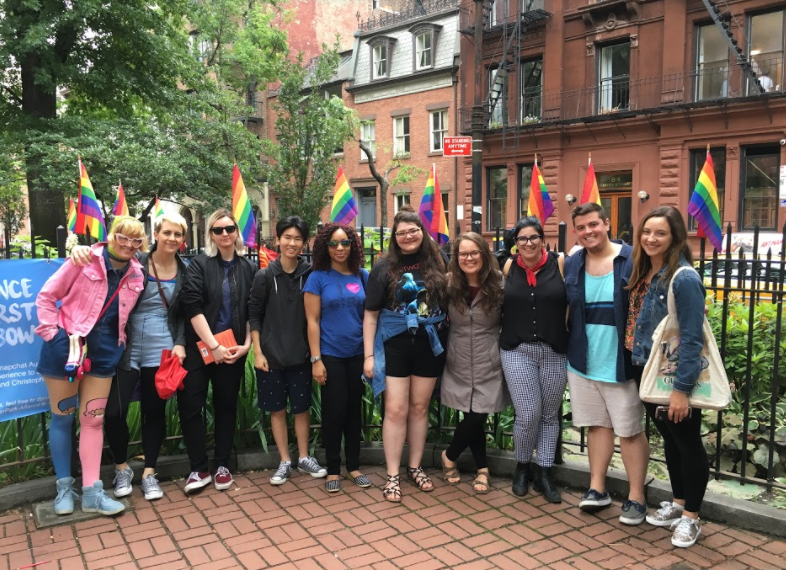
It’s really inspiring for me. I’ve always had supportive parents; I feel very fortunate in that way. But I know even today there are still LGBTQ youth who are not supported by their parents. It’s so sad. We talk about the AIDS epidemic, when people were literally on their deathbeds and they couldn’t call their mothers because they had been disowned. You think we’re so much better off 30, 40, or 50 years later, and in a lot of ways we are — we do have some fundamental rights we did not have in 1980, or even 1990, or even 2000! There’s so much that has changed.
But at the same time, there are still these very real lived experiences. My focus and passion is with LGBTQ youth. It’s really inspiring to me because I know those stories exist, but then to see a parent who comes to me and says, “I’m here because I want to learn more and I want to be a better ally for my child”… I’m getting emotional just thinking about it. These past few parents that have come, it’s so selfless — they just want to do what they can. So many parents don’t know how to support their LGBTQ children, especially if they come from a rural or suburban place.
That’s another thing about the tour; I’m also able to connect them with organizations that are doing amazing work with LGBTQ youth all over the world and country. PFLAG is a great one that I recommend for parents, family and friends of LGBTQ youth. There’s also The Trevor Project for LGBTQ youth. There are so many different organizations, and I think many parents and even youth don’t necessarily know they can have access to these things because it’s so not their world. It wasn’t my world really until I started these tours and became connected with all of these organizations that are doing this work just within this past year or so.
One more thing about LGBTQ youth: we do offer specific tours for LGBTQ youth. If any LGBTQ youth wants to come on a tour, we offer that for free in alignment with our mission that we want LGBTQ history to be accessible to all folks. With that, we have our general walking tour, but if there’s anyone under 21 who wants to join us on the tour, we give it to them for free. We also have discounts for students who aren’t LGBTQ youth but still want to learn, as well as seniors.
For me it’s just more about sharing the stories and histories, but especially for that population, I think it’s even more important because they are the next generation of changemakers. My hope is they can come on the tour and there are no barriers, financial access or otherwise, so they can then feel inspired to create their own change.
So much of the reason behind my tours is just access to the history. We share stories and uplift voices from those who paved the way before us. It’s really more about story sharing from these folks who may have been forgotten or idolized in the community. I think leading up to World Pride and Stonewall 50, it’s really important to be able to share that message.
Keep up with Christopher Street Tours on Instagram or Facebook.
Most photos by Ifaa Amit.
